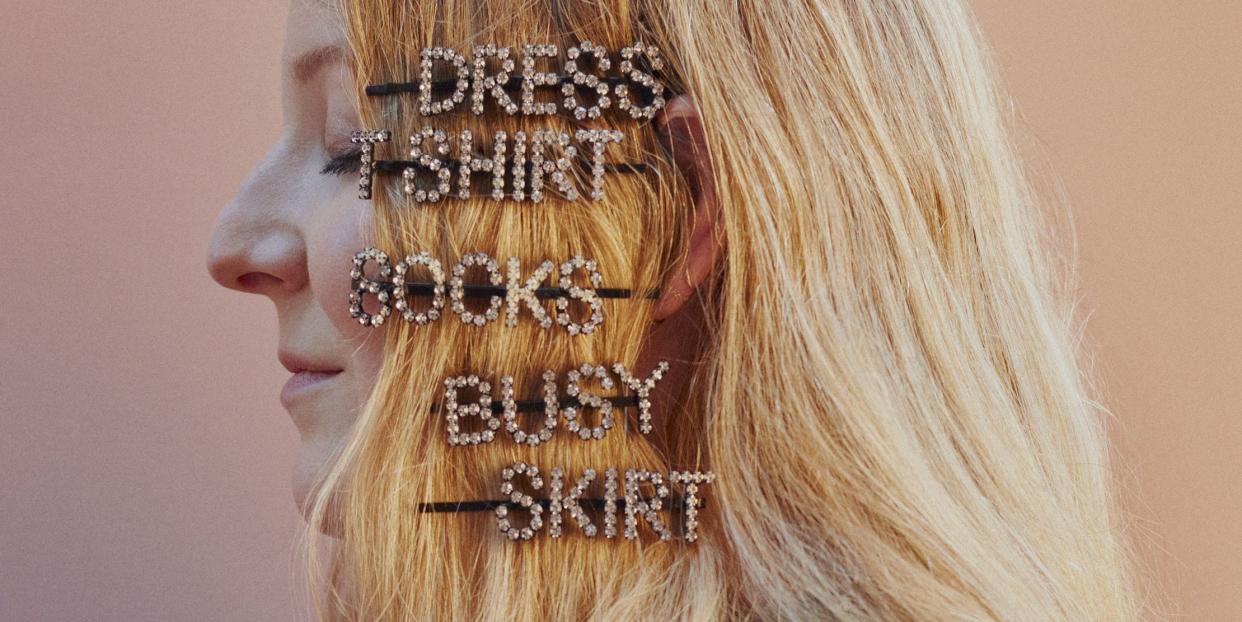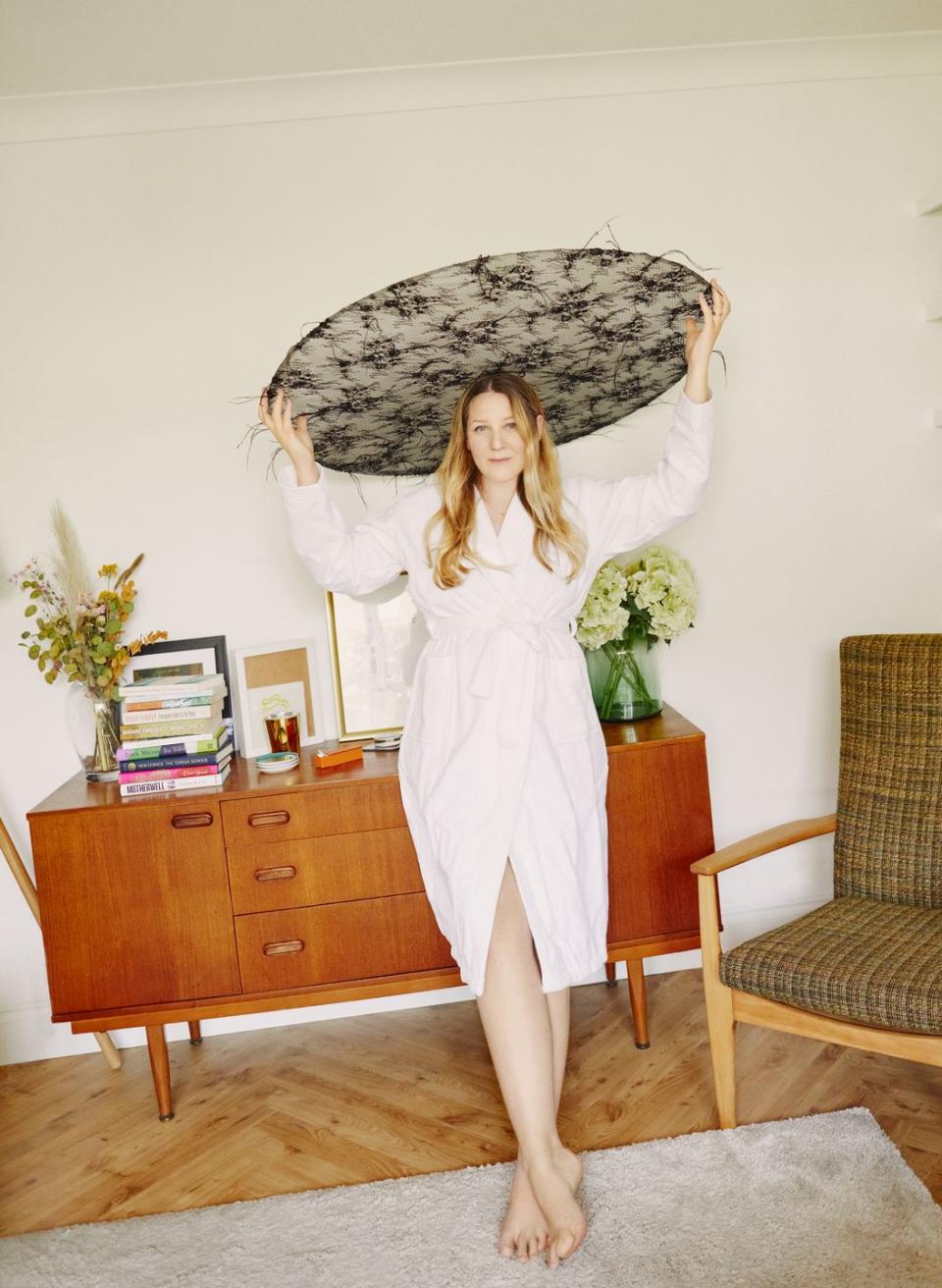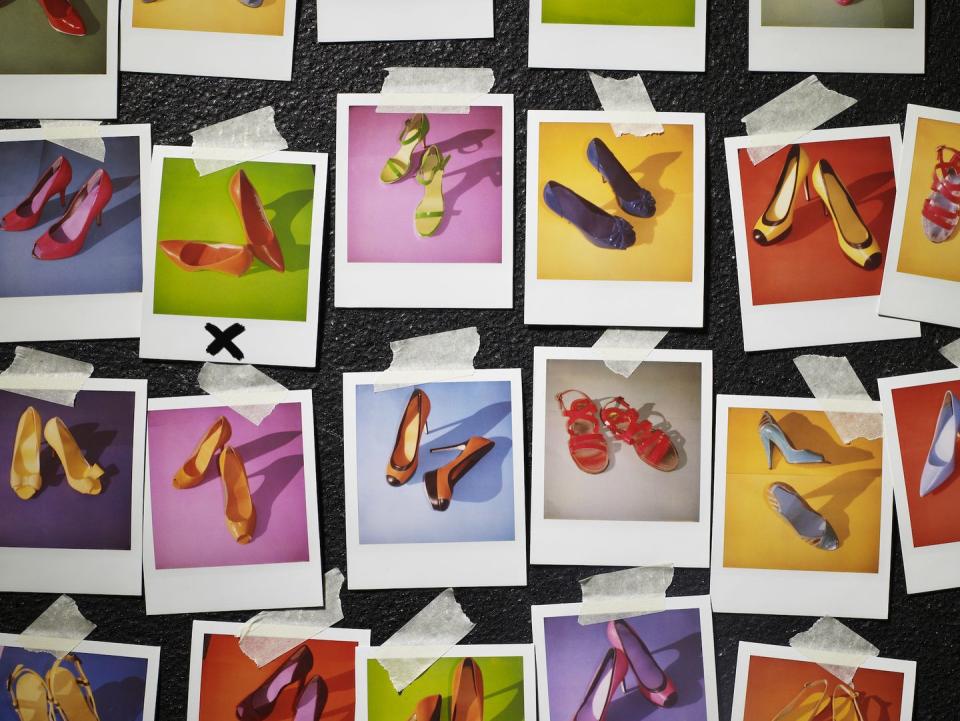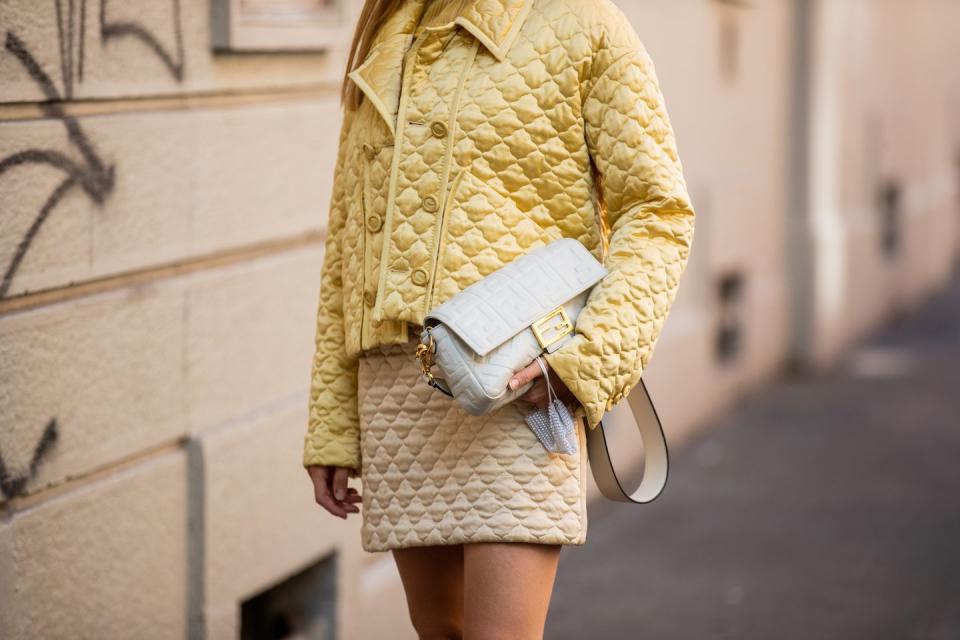‘I’m A Fashion Editor Who Had To Ditch "The Devil Wears Prada" Stereotype'

I was crying outside a five-star hotel in LA when I realised I didn’t know who I was anymore. Hunched in a chair – in that bright, clean sunlight that first brought filmmakers to Hollywood – I was wearing a leather Rick Owens jacket with a Comme des Garçons dress and split-toe Maison Margiela Tabi boots: all black. And my skin was as white as everyone else’s teeth.
The shiny Californians around me were drinking green juices and laughing while I chugged gin and tonics and chain-smoked cigarettes, until one of the waiters explained to me that it was ‘literally illegal’ to smoke outdoors there.
She had the open face, straight teeth and wholesome blonde hair of a cereal bar advert; my rather severe asymmetrical black bowl cut – which had seemed so on-point in London – made me feel like Gollum by comparison.
A fashion writer on a broadsheet newspaper, I was there with a group of other style press for a story on a new Hollywood costume exhibition, and spent most of that week either drunk or unsuccessfully trying not to talk about the Big Break-Up I had run away from at home.

Somewhere between losing my Jil Sander clutch (and my dignity) in a club on the first night and hiding behind a shrub to smoke one last forbidden fag before the flight home, I made my first proper ‘fashion’ friends: a pair of uber-cool editors who balanced their obvious street cred with warmth and down-to-earth friendliness. It was then I realised that being in fashion was a job, not a personality type.
I’d been compensating for so many of my insecurities by dressing and behaving a certain way that I felt completely lost. When my long-term relationship ended, I no longer had a ‘me’ to fall back on. It took being this far from home to realise what needed to change when I returned.
Before I was a goth, I was a nerd. Bookish and socially anxious at school, I’d always loved clothes, always pored over pictures from the catwalks, but I lived in fear of barbed comments from the more popular girls in our rowdy common room.
I grew up in Sheffield, a bustling northern city with a brilliant club scene, but in my teenage corner of it the dress code was early Noughties conservative: bootcut jeans and a nice top.
Anything more adventurous earned a dose of caustic Yorkshire wit, designed to cut you back down to size and doled out in front of a crowd to cause maximum embarrassment. I craved the anonymity of London, the fact that nobody there seemed to care how anyone else looked.
For me then, fashion was about how I wanted to feel – grown-up and sophisticated – not how I looked. I treasured my older sister’s fashion magazines like sacred texts, reciting the boutiques and bars they named like prayers.
I worshipped Jodie Kidd and Kate Moss for being cool and flat-chested (the two were mutually exclusive at my school), and devoured newspaper fashion pages, in which clever, offbeat women proved with zingy quips that being interested in clothes didn’t make you thick.

I wanted to be one of them, but I didn’t have a clue where to start. After university, I sent my CV off for internships that I thought might end with a writing job – and was surprised when, on my first day at a magazine 13 years ago, I spent the full eight hours folding jumpers in a cupboard.
I ended my day by packaging up a diamond necklace worth £100,000, before taking it downstairs to the security guard who accompanied it almost everywhere in a black Mercedes. Then I went to do my other job – the one that actually paid me – at a pub near my flat in Brixton.
I spent my days drowning in designer gear, sending back samples worth three times my rent from overflowing fashion cupboards to press offices on august Parisian avenues. My evenings were for being jeered at by the drunk old guys who clustered by the glass-wash.
I’m hardly the only graduate to have subsidised their dreams like this, but the drip trays and grumpy regulars kept me grounded. I handled pints of their Guinness with as much care as I did a £13,000 Burberry handbag, turned up on time for both of my shifts, and spent each night burying any complaints I had under a veneer of cheerful servitude.
It was as good an education as my university degree – it kept me honest as well as cynical. I’ve always remembered that, beyond the Chelsea beau monde and the Hackney trust-funders, there’s an entirely separate realm of people who couldn’t care less about the latest trends or what their clothes might say about them, for whom getting dressed is just what you do after brushing your teeth.

I shared my perch in those fashion cupboards with other aspiring interns, many of whom had exotic existences: there was the European princess who expected doors to be opened for her, the A-list 'It'-girl’s best friend (or so she said), the part-time escort who’d have a bump of coke at lunch instead of a Pret sandwich.
If any of us were going to make it in fashion, I assumed bleakly, it probably wouldn’t be me. I never felt fabulous enough to fill the shoes I tried on in secret when the cupboard door swung closed.
My friends were all on well-paid grad schemes or sensible law conversion courses; I had no money and no immediately apparent career path, but what I was doing at least had the veneer of cool. So I played up to their fascination with the glamorous world I now in some very small way inhabited, wafting make-up samples from the beauty cupboard around in the pub, dropping names and struggling everywhere in heels – partly because I loved to dress up, but mainly because all the women in the magazine offices did. It was The Devil Wears Prada era, after all.
It never struck me that, at 5ft 8in, I didn’t really need heels – or that perhaps those other women weren’t in theirs at the weekend. When I wore five-inch platforms to a friend’s birthday picnic that summer, I mistook feeling out of place among everyone’s sandals as some kind of fashion epiphany: they were not the wrong shoes; it was the wrong party.

My social life changed when I got my first job as an assistant at a prestigious magazine. The salary was tiny, but so much else was free that my lifestyle became subsidised overnight: shampoo from the beauty desk; lunch was the sushi or pizza delivery that just turned up in the office; and, of course, the parties. One to attend every night of the week if you wanted to – which I did, with a regulation fashion boyfriend who worked in the sort of Shoreditch office where everyone wore tiny bowler hats.
As the rest of my circle settled into jobs with gruelling hours but rewarding salaries, I saved most of what I earned for my rent by eating and drinking at sponsored events. Everyone did. There were good nights and bad nights, nights that promised the earth but petered out by 9pm and ones called to a halt only by the fact it was time to return to our desks the next morning.
There were nights at Trash and Sketch, where Alexa Chung always seemed to be DJing and Amy Winehouse might be in the corner, while the rest of us shimmied about in Luella dresses we’d ‘borrowed’ from the fashion cupboard.
I once went to McDonald’s afterwards in a full Marc Jacobs catwalk look, and still lie awake now at the sheer hubris of youth not to even consider the potential for ketchup catastrophe.
But I never really felt at ease in those clothes – I knew I was wearing them just so I could say I had. Much like attending those parties, in fact, where people spent most of the night looking over each other’s shoulders at the rest of the room. So much of fashion’s self-mythologising is about hyping the now in the hope it will one day be seen as the glory days.
Every industry creates its own collateral damage, but the bodies tend to mount up in fashion. Partly, it’s down to supply and demand: more people want to break in than there are vacancies.
Yet there’s a certain amount of being chewed up and spat out: flavour of the month only holds attention for so long. Fashion feeds on people who burn bright – but is it possible to maintain the spark for the length of a career? How does anybody balance every new trend with the important business of being true to oneself?

I was only ever one of many moths circling the flame. At the centre were the all-or-nothings who would make it big or die trying. Where are the green-haired Hoxton boys and girls now? Or the ones who wore desk fans and vagina hats to Fashion Week? At one party, I was offered heroin by someone wearing a fresh-from-the-catwalk look with a gimp mask; who knows who they were or whether they’re still around.
These were the ‘real’ fashion people – the ones who lived it 24/7, like Leigh Bowery or the Warhol set, with nothing so humdrum as a day job to get in the way. Next to them, I felt embarrassed at how normal my life was beneath it all. But when I told a friend about the heroin a few days later, she looked horrified. I’d been so worried about being cool that I’d forgotten there was comfort in not living on the edge.
I got my first newspaper job soon afterwards – removed from the catwalk coalface of glossy magazines, I was more likely to bump into a man my father’s age around the office, and more used to hearing football chat in the building’s lifts. I still wore black, still went to some of the parties, but I always left well ahead of the sun coming up, now I knew things always looked better in the dark.
When I got home from that LA trip, I bought a pink T-shirt. Then some blue printed trousers. I began to wear flats, grew out my Gollum fringe, eventually stopped smoking. I got over the FOMO and began to turn down the invitations. Being on the scene suits a time in one’s professional life, but the guest list isn’t everything. I tried hard to be kinder, less judgemental, less fashion-bitchy. I began to work with and write for the women I had admired while at school.
A post shared by Harriet Walker (@_harrywalker1) on Sep 22, 2020 at 5:36am PDT
There was an evening when I went to an event – another cocktail party in a packed boutique, I imagine – and saw mostly myself, only three years previously: jostling juniors for whom everything was still shiny and new.
It was their turn now; I felt like a decorated veteran as I left to meet friends in the pub instead. The way to make it in fashion is the same as in any job – be reliable, diligent and friendly. Now that nobody has the time or budgets that divas require, there are far fewer of them. I hear that the woman who used to throw her shoes at colleagues and forbade them to eat in the office now does a lot of charity work.
Ten years on, I feel more journalist than fashion editor: a reporter rather than a clothes horse. I write about the industry for a living; I am not, and never was, the story. I still wear black sometimes, but mainly because it camouflages the various smears my toddler leaves on me.
When people find out I’m fashion editor at The Times, they either ask excited questions about what I do, or look completely baffled. I sometimes feel a bit sorry for the ones who come across me wearing jeans, trainers and not much make-up, and begin not- so-subtly searching for the Devil beneath my Prada. Not that I’d wear anything that major at the weekend anymore, of course.
The New Girl by Harriet Walker is out now.
This article originally appeared in the September issue of ELLE UK. Like this article? Sign up to our newsletter to get more articles like this delivered straight to your inbox.
In need of more inspiration, thoughtful journalism and at-home beauty tips? Subscribe to ELLE's print magazine today! SUBSCRIBE HERE
editoriallinks id='8331503c-20b1-456f-927c-c982804c0c76' align='center'][/editoriallinks]
You Might Also Like

 Yahoo News
Yahoo News 
